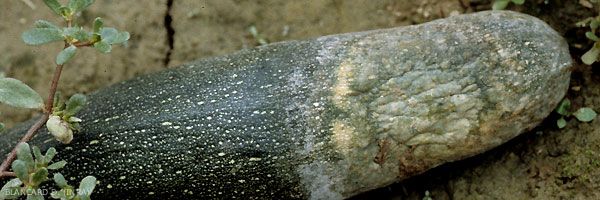
Main symptoms
Phytophthora capsici is an oomycete capable of attacking all organs of cucurbits.
It may be responsible for damping off seedlings in the nursery; these result in various rots affecting the hypocotyl, the crown and the first roots of the seedlings which soon wilt, collapse and gradually disappear.
On young and adult plants, a progressively browning wet lesion sometimes appears on the stem at soil level (Figure 1); this once surrounded leads to more or less irreversible wilting of the plants and their death in the long term. Note that the vessels underlying this lesion are more or less brown. The roots can rot, so they become soft and take on a brown tint before decomposing.
The leaves touch the ground or subjected projections of contaminated soil particles (via Splash) may be affected. In this case, they present spots, or even more or less extensive areas, livid to yellowish, darkening, browning and necrosis rather quickly (figures 2 and 3). The twigs may show lesions which are also moist, dark, progressing to dark brown (Figure 4). These, once the stem is girdled, induce wilting of the leaves and death of the distal part of the branch.
Moist lesions appear especially on the part of the fruits in contact with the ground. They can sometimes be initiated elsewhere, from the peduncle (figure 5) or the stylar end (figure 6), and / or after contact of the fruits with other contaminated aerial organs, or following splashing occurring after rain or sprinkler irrigation. These lesions are firm long enough and may become covered with a white to grayish mycelium (Figure 7). Their center softens at the end of the evolution. They quickly transform into rot which spreads to the fruit and causes its more or less complete decomposition.
In addition, green fruits, such as those having reached an advanced stage of maturity, can be affected. In addition, such alterations can also appear on fruits during transport and storage.





